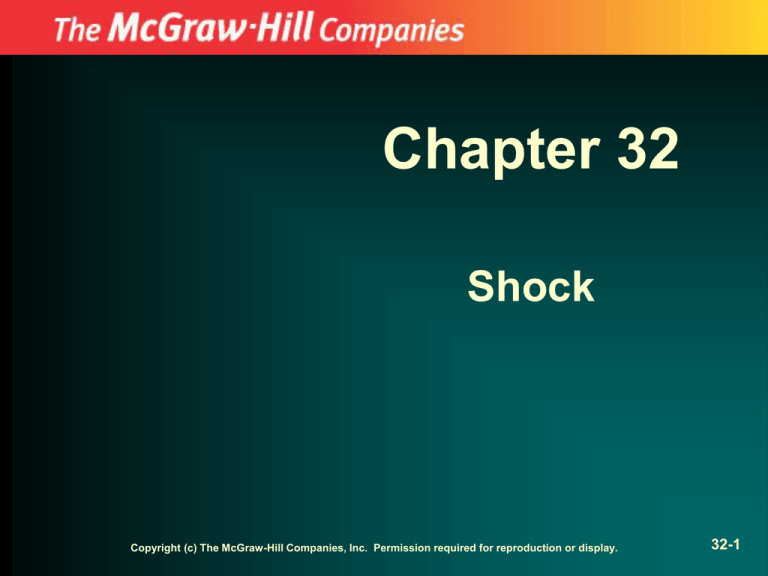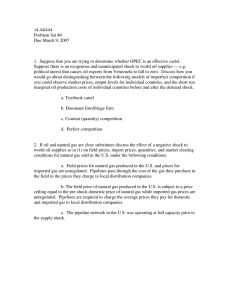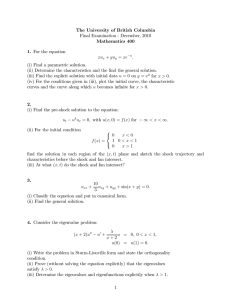Chapter 32 Shock 32-1
advertisement

Chapter 32 Shock Copyright (c) The McGraw-Hill Companies, Inc. Permission required for reproduction or display. 32-1 Objectives 32-2 Perfusion • Circulation of blood through an organ or a part of the body • Shock – Inadequate circulation of blood through an organ or a part of the body = inadequate perfusion 32-3 Cardiogenic Shock (Pump Failure) • Possible causes: – Heart attack – Too fast or too slow heart rhythm – Injury to the heart – Other conditions that affect the heart’s ability to pump 32-4 Hemorrhagic Shock (Volume Problem) • Caused by severe bleeding • Bleeding may be internal, external, or both 32-5 Hypovolemic Shock (Volume Problem) • Shock caused by: – Loss of blood (trauma) – Loss of plasma (burns) – Other body fluid • Vomiting • Diarrhea • Excessive sweating • Excessive urination 32-6 Obstructive Shock • Blood flow is slowed or stopped by a mechanical or physical obstruction – Cardiac tamponade – Tension pneumothorax 32-7 Distributive Shock (Pipe Problem) • Blood vessels lose ability to adjust flow of blood – Blood vessels remain enlarged – Amount of fluid in the body remains constant – Blood pools in outer areas of the body – Not enough blood to fill enlarged vessels – Vital organs are not perfused 32-8 Distributive Shock (Pipe Problem) • Four major causes of this type of shock are: – Injury to the spinal cord • Neurogenic shock – Severe infection • Septic shock – Severe allergic reaction • Anaphylactic shock – Psychological causes • Psychogenic shock 32-9 Shock • Regardless of the type of shock: – Cells are starved for oxygen-rich blood • Without adequate oxygen: – Cells begin to break down – Waste products build up – Death may follow unless adequate perfusion is quickly restored 32-10 Stages of Shock • Early (compensated) • Late (decompensated) • Irreversible (terminal) 32-11 Stages of Shock Early Shock 32-12 Stages of Shock Late Shock 32-13 Irreversible Shock • • • • • Body’s defense mechanisms have failed Irregular pulse Heart can no longer effectively pump blood Permanent damage occurs to vital organs Eventually: – Heart stops – Breathing stops – Death results 32-14 Common Causes of Shock in Children • Trauma • Fluid loss • Infection • Anaphylaxis • Congenital heart disease • Chest wall injury 32-15 Indicators of Shock • Altered mental status • Tachycardia • Weak distal pulses • Delayed capillary refill time • Cool, mottled extremities 32-16 Infants and Children • Can maintain normal blood pressure until more than half their blood volume is gone • By the time their blood pressure drops, they are close to death • Tend to compensate longer but get worse faster when compensatory mechanisms fail 32-17 Capillary Refill • Assess capillary refill in children younger than 6 years of age • Delayed capillary refill in an infant 32-18 Mottled Skin in a Child 32-19 Older Adults • Suspect septic shock if tachycardic and hypotensive if other causes of shock are not obvious. • Difficulty tolerating hypotension caused by hemorrhage • Beta-blockers, calcium channel blockers 32-20 Older Adults • Airway – Arthritis of cervical vertebrae – Dentures – Coughing often ineffective • Breathing – Higher resting respiratory rate – Lower tidal volume – Less elasticity/compliance of the chest wall • Circulation – Higher resting heart rate – Irregular pulse 32-21 Emergency Care of Shock • Scene size-up – Evaluate mechanism of injury or nature of the illness – Put on appropriate PPE • Perform a primary survey – Stabilize cervical spine if needed – Manage airway and breathing – Control all obvious external bleeding 32-22 Emergency Care for Shock • Place patient supine – Raise feet 6 to 12 in if no trauma present • Give oxygen • Prevent heat loss • Perform physical examination • Take vital signs, gather medical history • Rapid transport • Splint any bone or joint injuries en route • Comfort, calm, and reassure patient • Reassess at least every 5 minutes 32-23 Questions? 32-24




